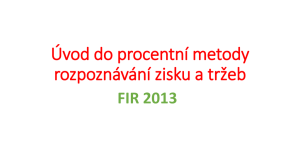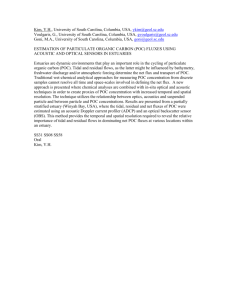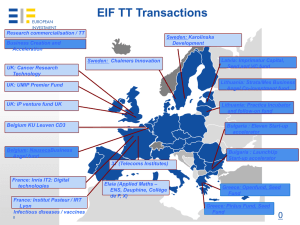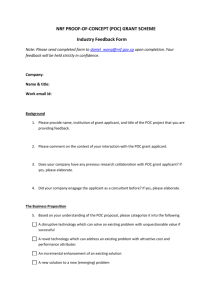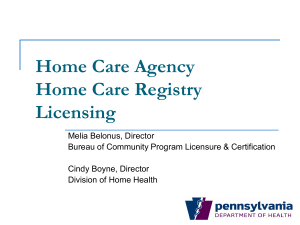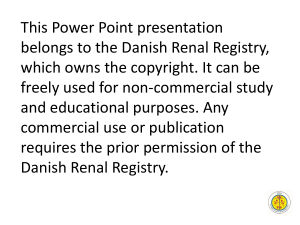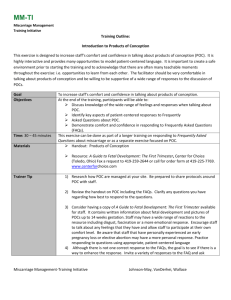Making Sense of the PA/POC Requirements
advertisement
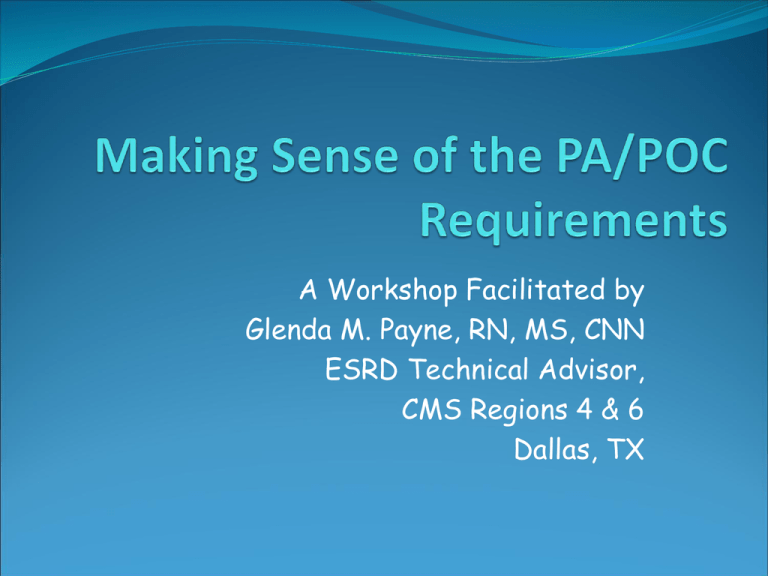
A Workshop Facilitated by Glenda M. Payne, RN, MS, CNN ESRD Technical Advisor, CMS Regions 4 & 6 Dallas, TX First, let’s talk about: The basic ESRD regulatory requirements for patient assessments and plan of care… Every Patient Must Have Individualized Patient Assessment Individualized Plan of Care By Interdisciplinary Team Done Timely Implemented Reviewed and Updated as Indicated Who Is Needs to Be Involved? IDT includes at a minimum: The patient or their designee (if the patient chooses) A registered nurse A physician treating the patient for ESRD A social worker A dietitian 4 Multidisciplinary Care vs. Interdisciplinary Care Multidisciplinary Interdisciplinary Work sequentially Work collaboratively Medical record is the chief means of communication Communication by regular discussions about patient status & the evolving plan of care 5 Timelines for Patient Assessments New admits: Initially: Latter of 30 days/13 treatments Reassessment: 90 days after initial assessment Transfers/transients: If they come with: use that for 3 months, then reassess If they don’t come with: 30 days/13 treatments Stable patients: annually Unstable patients: monthly Who Is “Unstable?” Includes but is not limited to: Extended or frequent hospitalization (>15 days or >3 X a month) Marked deterioration in health status Significant change in psychosocial needs Concurrent poor nutritional status, unmanaged anemia & inadequate dialysis 7 When Must POC Be Implemented? First assessment: within the same timeframe as the assessment (latter of 30 days/13 treatments) Any reassessment: 15 days after reassessment completed What About Stable Patients? If a “stable” patient’s outcomes do not meet the care plan goals in an area, the facility must recognize and address that aspect and revise the plan of care accordingly between annual comprehensive reassessments “Monitor, Recognize and Address” 9 Take It To the MAT Measures Assessment Tool Current, professionally accepted clinical practice standards of care at your fingertips Common understanding of expected targets/goals Let’s take a look at the MAT… What Do You Need to Document? Process for patient assessment Patient plan of care development Goals Timelines Plan of care implementation Plan of care review/revision 11 Where Would This Work Be Documented? Assessments Plan of Care Orders for treatment Interdisciplinary progress notes Lab results Dialysis treatment records PD flow sheets and clinic notes HD treatment records-pre/post assessments, monitoring during treatment 12 Dialysis treatment records? Home patients: PD – look at 1-3 mo flowsheets ; HHD - 10-15 treatments: Is the patient following dialysis prescription? In-center Hemo - look at 10-15 treatments: Staff following dialysis prescription? BFR,DFR, dialyzer, dialysate, heparin, Na/UF profile Medications administered as ordered? Anemia management Mineral/bone disorder management Immunizations, ABT, other meds BP/ Fluid management 13 Documenting Implementation Patient Plan of Care Interdisciplinary progress notes Nursing interventions Social services interventions Dietary counseling/education Referrals for rehab, vascular access, etc. 14 Documenting Implementation Patient education Modalities/self-care, home dialysis, transplantation Emergency procedures Infection prevention, immunizations, personal care, vascular access care Home training 15 CfC: PA and POC Two interlocked Conditions: §494.80 Condition: Patient Assessment §494.90 Condition: Patient Plan of Care Corresponding requirements Patient Plan of Care “uses” Patient Assessment Doing either in isolation will not accomplish the intended goal: Individualized Care Correlation of PA & POC PA POC Current health status (V502) Lab profile (V505) Medication/immunization history (V506) Incorporated into all POC tags Appropriateness of dialysis prescription (V503) Provide adequate clearance (V544) BP/fluid management needs (V504) Manage volume status (V543) Assess anemia (V507) Manage anemia (V547) Home pt ESA (V548) ESA response (V549) Assess renal bone disease (V508) Manage mineral metabolism (V546) 17 Correlation of PA & POC PA POC Nutritional status (V509) Effective nutritional status (V545) Psychosocial needs (V510) Evaluate family support (V514) Psychosocial counseling/referrals/ assessment tool (V552) Access type/maintenance (V511) VA monitor/referral (V550) Monitor/prevent failure (V551) Evaluate for self/home care (V512) Home dialysis plan (V553) Transplantation referral (V513) Transplantation status: plan or why not (V554) Evaluate current physical activity level & voc/physical rehab (V515) Rehab status addressed (V555) 18 ESRDSurvey@cms.hhs.gov Now to Let You Do Some Work! In order for you to demonstrate knowledge of the link between the patient assessment and the plan of care for that specific patient, and To identify critical components of the POC for specific patients, We have created several case studies for your “IDT” to use in developing or updating POCs… Pitfalls to Effective PA/POC Doing great assessments; not doing a plan of care Not using the information gathered in the assessment to develop the POC Not implementing the plan Not reviewing the results to see if the plan is working Not updating the plan to change or refocus the goal(s) Not monitoring the individual’s progress after interventions are implemented Discussion…

